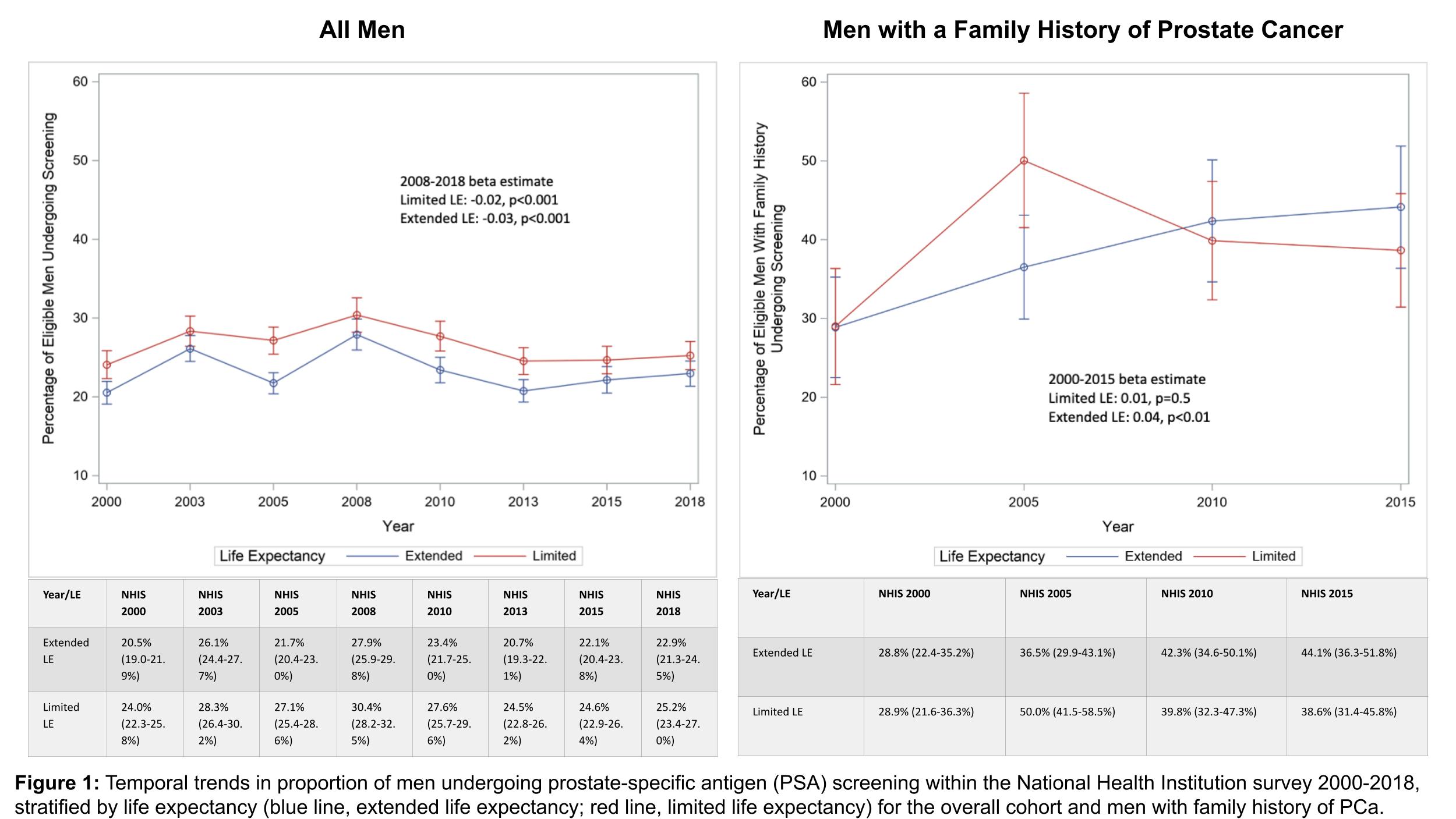Back
Poster, Podium & Video Sessions
Moderated Poster
MP53: Prostate Cancer: Detection & Screening V
MP53-19: Prostate Specific Antigen Screening Utilization in Men with a Family History of Prostate Cancer and Extended Life Expectancy
Monday, May 16, 2022
7:00 AM – 8:15 AM
Location: Room 225
Taylor Malchow*, Dayton, OH, Deepansh Dalela, Sami Majdalany, Austin Piontkowski, Nicholas Corsi, Ivan Rakic, Marcus Jamil, Detroit, MI, Akshay Sood, Houston, TX, Sohrab Arora, Craig Rogers, Detroit, MI, Mara Schonberg, Boston, MA, Firas Abdollah, Detroit, MI
- TM
Taylor J. Malchow, BA
Boonshoft Wright State School of Medicine
Poster Presenter(s)
Introduction: Life expectancy (LE) estimation is crucial to assess the benefit of prostate specific antigen (PSA) screening. Limited data exists for PSA screening in men with extended LE, especially men with a family history (FHx) of prostate cancer (PCa). The purpose of our study was: 1) to analyze PSA screening temporal trends in men with limited LE ( <5-10 years) vs. extended LE (>15 years) for men with a FHx of PCa; and 2) to examine the relative contribution of LE in PSA screening.
Methods: We identified men aged =40 years without a history of PCa who underwent PSA screening from the National Health Institution Survey (NHIS) from 2000-2018. We used the previously validified Schonberg index to assess LE. Our population was stratified based on limited vs. extended LE and PCa risk. Multivariable logistic regression models and dominance analyses were performed to study the relationship between LE and PSA screening and the strength of covariates in predicting screening rates, respectively.
Results: Overall, PSA screening declined significantly regardless of LE. PSA screening increased significantly in men with extended LE and a FHx of PCa (28.8% in 2000 to 44.1% in 2015), and non-significantly declined for men with limited LE (Figure 1). There was not a significant relationship between survey year and LE for PSA screening in men with a FHx of PCa (OR=1.11, p=0.5). Instead, prior colonoscopy, visit with a health care provider within the last year, and marital status were the strongest predictors of PSA screening (54.7%, 29.2% and 12.5% respectively).
Conclusions: For US men with extended LE, only 1 in 4 receive PSA screening, with a temporal decline. Screening rates for men with a FHx of PCa with extended LE increased; however, this change was driven by access to health care and coloscopy screening rather than LE. Discussion of PSA screening should be individualized in the context of these factors.
Source of Funding: None

Methods: We identified men aged =40 years without a history of PCa who underwent PSA screening from the National Health Institution Survey (NHIS) from 2000-2018. We used the previously validified Schonberg index to assess LE. Our population was stratified based on limited vs. extended LE and PCa risk. Multivariable logistic regression models and dominance analyses were performed to study the relationship between LE and PSA screening and the strength of covariates in predicting screening rates, respectively.
Results: Overall, PSA screening declined significantly regardless of LE. PSA screening increased significantly in men with extended LE and a FHx of PCa (28.8% in 2000 to 44.1% in 2015), and non-significantly declined for men with limited LE (Figure 1). There was not a significant relationship between survey year and LE for PSA screening in men with a FHx of PCa (OR=1.11, p=0.5). Instead, prior colonoscopy, visit with a health care provider within the last year, and marital status were the strongest predictors of PSA screening (54.7%, 29.2% and 12.5% respectively).
Conclusions: For US men with extended LE, only 1 in 4 receive PSA screening, with a temporal decline. Screening rates for men with a FHx of PCa with extended LE increased; however, this change was driven by access to health care and coloscopy screening rather than LE. Discussion of PSA screening should be individualized in the context of these factors.
Source of Funding: None


.jpg)
.jpg)